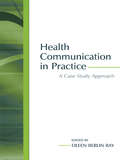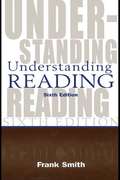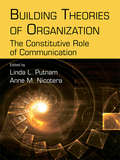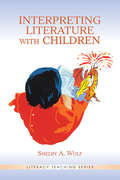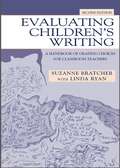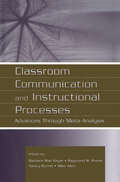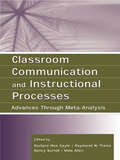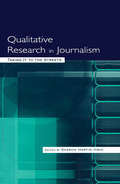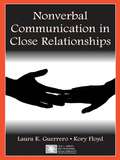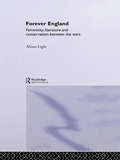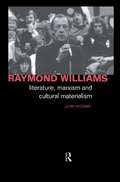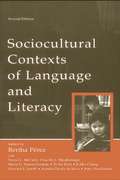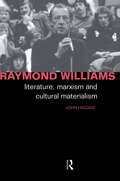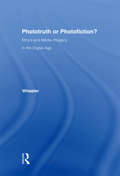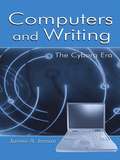- Table View
- List View
Health Communication in Practice: A Case Study Approach
by Eileen Berlin RayHealth Communication in Practice: A Case Study Approach offers a comprehensive examination of the complex nature of health-related communication. This text contains detailed case studies that demonstrate in-depth applications of communication theory in real-life situations.With chapters written by medical practitioners as well as communication scholars, the cases included herein cover a variety of topics, populations, contexts and issues in health communication, including:*provider-recipient communication and its importance to subsequent diagnosis and treatment;*decision-making;*social identity, particularly how people redefine and renegotiate their social identity;*communication dynamics within families and with health care providers through unexpected health situations;*delivery of health care; and*health campaigns designed to disseminate health-related information and change behaviors.Reflecting the changes in health communication scholarship and education over the past decade, chapters also explore current topics such as delivering bad news, genetic testing, intercultural communication, grieving families, and international health campaigns. A list of relevant concepts and definitions is included at the end of each case to help students make connections between the scenario and the communication theories it reflects.With its breadth of coverage and applied, practical approach, this timely and insightful text will serve as required reading in courses addressing the application of communication theory in a health-related context.
Understanding Reading: A Psycholinguistic Analysis of Reading and Learning to Read
by Frank SmithUnderstanding Reading revolutionized reading research and theory when the first edition appeared in 1971 and continues to be a leader in the field. In the sixth edition of this classic text, Smith's purpose remains the same: to shed light on fundamental aspects of the complex human act of reading--linguistic, physiological, psychological, and social--and on what is involved in learning to read. The text critically examines current theories, instructional practices, and controversies, covering a wide range of disciplines but always remaining accessible to students and classroom teachers. Careful attention is given to the ideological clash that continues between whole language and direct instruction and currently permeates every aspect of theory and research into reading and reading instruction. To aid readers in making up their own minds, each chapter concludes with a brief statement of "Issues." Understanding Reading: A Psycholinguistic Analysis of Reading and Learning to Read, Sixth Edition is designed to serve as a handbook for language arts teachers, a college text for basic courses on the psychology of reading, a guide to relevant research on reading, and an introduction to reading as an aspect of thinking and learning. It is matchless in integrating a wide range of topics relative to reading while, at the same time, being highly readable and user-friendly for instructors, students, and practitioners.
Understanding Reading: A Psycholinguistic Analysis of Reading and Learning to Read
by Frank SmithUnderstanding Reading revolutionized reading research and theory when the first edition appeared in 1971 and continues to be a leader in the field. In the sixth edition of this classic text, Smith's purpose remains the same: to shed light on fundamental aspects of the complex human act of reading--linguistic, physiological, psychological, and social--and on what is involved in learning to read. The text critically examines current theories, instructional practices, and controversies, covering a wide range of disciplines but always remaining accessible to students and classroom teachers. Careful attention is given to the ideological clash that continues between whole language and direct instruction and currently permeates every aspect of theory and research into reading and reading instruction. To aid readers in making up their own minds, each chapter concludes with a brief statement of "Issues." Understanding Reading: A Psycholinguistic Analysis of Reading and Learning to Read, Sixth Edition is designed to serve as a handbook for language arts teachers, a college text for basic courses on the psychology of reading, a guide to relevant research on reading, and an introduction to reading as an aspect of thinking and learning. It is matchless in integrating a wide range of topics relative to reading while, at the same time, being highly readable and user-friendly for instructors, students, and practitioners.
Building Theories of Organization: The Constitutive Role of Communication (Routledge Communication Series)
by Linda L. Putnam Anne M. NicoteraThis volume explores the concept of communication as it applies to organizational theory. Bringing together multiple voices, it focuses on communication’s role in the constitution of organization. Editors Linda L. Putnam and Anne Maydan Nicotera have assembled an all-star cast of contributors, each providing a distinctive voice and perspective. The contents of this volume compare and contrast approaches to the notion that communication constitutes organization. Chapters also examine the ways that those processes produce patterns that endure over time and that constitute the organization as a whole. This collection bridges different disciplines and serves a vital role in developing dimensions, characteristics, and relationships among concepts that address how communication constitutes organization. It will appeal to scholars and researchers working in organizational communication, organizational studies, management, sociology, social collectives, and organizational psychology and behavior.
Interpreting Literature With Children
by Shelby A. WolfClearly organized and beautifully written, Interpreting Literature With Children is a remarkable book that stands on the edge of two textbook genres: the survey of literature text and the literary criticism text. Neither approach, however, says enough about how children respond to literature in everyday classroom situations. That is the mission of this book. It begins by providing a solid foundation in both approaches and then examines multiple ways of developing children's literary interpretation through talk, through culture, class, and gender, as well as through creative modes of expression, including writing, the visual arts, and drama. The result is a balanced resource for teachers who want to deepen their understanding of literature and literary engagement. Because of its modest length and price and its ongoing focus on how to increase student engagement with literature, either pre-service or practicing teachers can use this text in children's literature, language arts, or literacy and language courses.
Interpreting Literature With Children
by Shelby A. WolfClearly organized and beautifully written, Interpreting Literature With Children is a remarkable book that stands on the edge of two textbook genres: the survey of literature text and the literary criticism text. Neither approach, however, says enough about how children respond to literature in everyday classroom situations. That is the mission of this book. It begins by providing a solid foundation in both approaches and then examines multiple ways of developing children's literary interpretation through talk, through culture, class, and gender, as well as through creative modes of expression, including writing, the visual arts, and drama. The result is a balanced resource for teachers who want to deepen their understanding of literature and literary engagement. Because of its modest length and price and its ongoing focus on how to increase student engagement with literature, either pre-service or practicing teachers can use this text in children's literature, language arts, or literacy and language courses.
Evaluating Children's Writing: A Handbook of Grading Choices for Classroom Teachers
by Suzanne Bratcher Linda RyanEvaluating Children's Writing: A Handbook of Grading Choices for Classroom Teachers, Second Edition introduces and explains a wide range of specific evaluation strategies used by classroom teachers to arrive at grades and gives explicit instructions for implementing them. Samples of student writing accompany the instructions to illustrate the techniques, and an appendix of additional student writing is provided to allow readers to practice particular evaluation strategies.More than just a catalog of grading options, however, this is a handbook with a point of view. Its purpose is to help teachers become intentional about their grading practices. Along with recipes for grading techniques, it offers a philosophy of evaluating student writing that encourages teachers to put grading into a communication context and to make choices among the many options available by determining the instructional purpose of the assignment and considering the advantages and disadvantages of particular grading strategies. Specific grading techniques are integrated with suggestions about the craft of evaluation--guidelines for instructional objectives, for student audience analysis, and for teacher self-analysis that help define communication contexts.New in the Second Edition:*a new chapter on state standards and assessments;*a reorganization of the chapter on approaches to grading;*additions to the chapter on management systems;*additions to the chapter on teaching yourself to grade;*additions to the annotated bibliography; and*updated references throughout the text.
Evaluating Children's Writing: A Handbook of Grading Choices for Classroom Teachers
by Suzanne Bratcher Linda RyanEvaluating Children's Writing: A Handbook of Grading Choices for Classroom Teachers, Second Edition introduces and explains a wide range of specific evaluation strategies used by classroom teachers to arrive at grades and gives explicit instructions for implementing them. Samples of student writing accompany the instructions to illustrate the techniques, and an appendix of additional student writing is provided to allow readers to practice particular evaluation strategies.More than just a catalog of grading options, however, this is a handbook with a point of view. Its purpose is to help teachers become intentional about their grading practices. Along with recipes for grading techniques, it offers a philosophy of evaluating student writing that encourages teachers to put grading into a communication context and to make choices among the many options available by determining the instructional purpose of the assignment and considering the advantages and disadvantages of particular grading strategies. Specific grading techniques are integrated with suggestions about the craft of evaluation--guidelines for instructional objectives, for student audience analysis, and for teacher self-analysis that help define communication contexts.New in the Second Edition:*a new chapter on state standards and assessments;*a reorganization of the chapter on approaches to grading;*additions to the chapter on management systems;*additions to the chapter on teaching yourself to grade;*additions to the annotated bibliography; and*updated references throughout the text.
Classroom Communication and Instructional Processes: Advances Through Meta-Analysis
by Barbara Mae Gayle Raymond W. Preiss Nancy Burrell Mike AllenThis volume offers a systematic review of the literature on communication education and instruction. Making meta-analysis findings accessible and relevant, the editors of this volume approach the topic from the perspective that meta-analysis serves as a useful tool for summarizing experiments and for determining how and why specific teaching and learning experiences have positive student outcomes. The topics covered here are meaningful and relevant to classroom practice, and each chapter offers a summary of existing quantitative social science research using meta-analysis. With contributions from experienced researchers throughout the communication discipline, this work provides a unique analysis of research in instructional communication.Taken together, the chapters in this volume enhance understanding of behaviors, practices, and processes that promote positive student outcomes. This book is a must-read for scholars, graduate students, and researchers in communication education, and will also be of interest to scholars and researchers in education.
Classroom Communication and Instructional Processes: Advances Through Meta-Analysis
by Barbara Mae Gayle Raymond W. Preiss Nancy Burrell Mike AllenThis volume offers a systematic review of the literature on communication education and instruction. Making meta-analysis findings accessible and relevant, the editors of this volume approach the topic from the perspective that meta-analysis serves as a useful tool for summarizing experiments and for determining how and why specific teaching and learning experiences have positive student outcomes. The topics covered here are meaningful and relevant to classroom practice, and each chapter offers a summary of existing quantitative social science research using meta-analysis. With contributions from experienced researchers throughout the communication discipline, this work provides a unique analysis of research in instructional communication.Taken together, the chapters in this volume enhance understanding of behaviors, practices, and processes that promote positive student outcomes. This book is a must-read for scholars, graduate students, and researchers in communication education, and will also be of interest to scholars and researchers in education.
Qualitative Research in Journalism: Taking It to the Streets
by Sharon Hartin IorioThis volume highlights the integration of qualitative research methods into traditional journalism, offering new ways of expanding and enhancing news coverage. Designed for readers without prior experience in social science research, this collection presents a wide variety of qualitative techniques and their applications in journalistic practice. The work brings together contributions from professional journalists and journalism scholars who are highly experienced in conducting qualitative research. These experts demonstrate how valid, reliable qualitative procedures can be used to increase coverage and offer new insights. Written in a straightforward, reader-friendly style, features in this volume include: *real-world examples from contemporary newsrooms and interviews with practicing journalists who use the techniques of qualitative research in reporting; *a rationale for the use of qualitative methods in journalism, with an illustration of how various qualitative methods tie together; *step-by-step instructions for applying each methodology; *a solid foundation for understanding the history and theory behind qualitative research and its usefulness in journalism; *chapters on pairing qualitative and quantitative methods in journalism and on detailing partnerships between academics and professional journalists to facilitate newsroom research and reporting; and *a discussion of "objectivity" in qualitative research and in journalism that offers an ethic for journalists of today. The methodologies covered here include oral and life histories, textual analysis, focused interviews, ethnographies, focus groups, and case studies. In addition, a recently developed technique, civic mapping, is presented as a qualitative tool for reporting. Qualitative Research in Journalism is an indispensable resource for current and future journalists interested in enhancing their coverage of the news.
Qualitative Research in Journalism: Taking It to the Streets
by Sharon Hartin IorioThis volume highlights the integration of qualitative research methods into traditional journalism, offering new ways of expanding and enhancing news coverage. Designed for readers without prior experience in social science research, this collection presents a wide variety of qualitative techniques and their applications in journalistic practice. The work brings together contributions from professional journalists and journalism scholars who are highly experienced in conducting qualitative research. These experts demonstrate how valid, reliable qualitative procedures can be used to increase coverage and offer new insights. Written in a straightforward, reader-friendly style, features in this volume include: *real-world examples from contemporary newsrooms and interviews with practicing journalists who use the techniques of qualitative research in reporting; *a rationale for the use of qualitative methods in journalism, with an illustration of how various qualitative methods tie together; *step-by-step instructions for applying each methodology; *a solid foundation for understanding the history and theory behind qualitative research and its usefulness in journalism; *chapters on pairing qualitative and quantitative methods in journalism and on detailing partnerships between academics and professional journalists to facilitate newsroom research and reporting; and *a discussion of "objectivity" in qualitative research and in journalism that offers an ethic for journalists of today. The methodologies covered here include oral and life histories, textual analysis, focused interviews, ethnographies, focus groups, and case studies. In addition, a recently developed technique, civic mapping, is presented as a qualitative tool for reporting. Qualitative Research in Journalism is an indispensable resource for current and future journalists interested in enhancing their coverage of the news.
Nonverbal Communication in Close Relationships
by Laura K. Guerrero Kory FloydNonverbal Communication in Close Relationships provides a synthesis of research on nonverbal communication as it applies to interpersonal interaction, focusing on the close relationships of friends, family, and romantic partners. Authors Laura K. Guerrero and Kory Floyd support the premise that nonverbal communication is a product of biology, social learning, and relational context. They overview six prominent nonverbal theories and show how each is related to bio-evolutionary or sociocultural perspectives. Their work focuses on various functions of nonverbal communication, emphasizing those that are most relevant to the initiation, maintenance, and dissolution of close relationships. Throughout the book, Guerrero and Floyd highlight areas where research is either contradictory or inconclusive, hoping that in the years to come scholars will have a clearer understanding of these issues. The volume concludes with a discussion of practical implications that emerge from the scholarly literature on nonverbal communication in relationships – an essential component for understanding relationships in the real world. Nonverbal Communication in Close Relationships makes an important contribution to the development of our understanding not only of relationship processes but also of the specific workings of nonverbal communication. It will serve as a springboard for asking new questions and advancing new theories about nonverbal communication. It is intended for scholars and advanced students in personal relationship study, social psychology, interpersonal communication, nonverbal communication, family studies, and family communication. It will also be a helpful resource for researchers, clinicians, and couples searching for a better understanding of the complicated roles that nonverbal cues play in relationships.
Nonverbal Communication in Close Relationships
by Laura K. Guerrero Kory FloydNonverbal Communication in Close Relationships provides a synthesis of research on nonverbal communication as it applies to interpersonal interaction, focusing on the close relationships of friends, family, and romantic partners. Authors Laura K. Guerrero and Kory Floyd support the premise that nonverbal communication is a product of biology, social learning, and relational context. They overview six prominent nonverbal theories and show how each is related to bio-evolutionary or sociocultural perspectives. Their work focuses on various functions of nonverbal communication, emphasizing those that are most relevant to the initiation, maintenance, and dissolution of close relationships. Throughout the book, Guerrero and Floyd highlight areas where research is either contradictory or inconclusive, hoping that in the years to come scholars will have a clearer understanding of these issues. The volume concludes with a discussion of practical implications that emerge from the scholarly literature on nonverbal communication in relationships – an essential component for understanding relationships in the real world. Nonverbal Communication in Close Relationships makes an important contribution to the development of our understanding not only of relationship processes but also of the specific workings of nonverbal communication. It will serve as a springboard for asking new questions and advancing new theories about nonverbal communication. It is intended for scholars and advanced students in personal relationship study, social psychology, interpersonal communication, nonverbal communication, family studies, and family communication. It will also be a helpful resource for researchers, clinicians, and couples searching for a better understanding of the complicated roles that nonverbal cues play in relationships.
Forever England: Femininity, Literature and Conservatism Between the Wars
by Alison LightFirst published in 1991. Routledge is an imprint of Taylor & Francis, an informa company.
Forever England: Femininity, Literature and Conservatism Between the Wars
by Alison LightFirst published in 1991. Routledge is an imprint of Taylor & Francis, an informa company.
Raymond Williams: Literature, Marxism and Cultural Materialism
by John HigginsRaymond Williams' prolific output is increasingly recognised as the most influential body of work on literary and cultural studies in the past fifty years. This book provides the most comprehensive study to date of the theoretical and historical context of Williams' thinking on literature, politics and culture. John Higgins traces: * Williams' intellectual development * the related growth of a New Left cultural politics * the origins of the theory and practice of cultural materialism. Raymond Williams is an astonishing achievement and will challenge many received ideas about Williams' work.
Sociocultural Contexts of Language and Literacy
by Teresa L. McCarty Lucille J. Watahomigie To Thi Dien Bertha Perez Mar¡a E. Torres-GuzmanSociocultural Contexts of Language and Literacy, Second Edition engages prospective and in-service teachers in learning about linguistically and culturally diverse students, and in using this knowledge to enrich literacy learning in classrooms and communities. The text is grounded in current research and theory that integrate sociocultural and constructivist concepts and perspectives and provide a framework teachers can use to develop strategies for teaching reading, writing, and thinking to diverse students. The focus on English literacy development does not imply advocacy for "English only" or ESL as the primary mode of literacy instruction. Rather, the authors take the position that learners need to develop literacy in their native language and that the concepts and skills learned in developing the native language create a foundation of strength from which students can develop English literacy. Part I introduces relevant research and language learning theories. Part II provides research reviews and information about literacy learning within specific culturally and linguistically diverse communities. The chapters in Part III challenge the reader to view the multiple social, intellectual, cultural, and language differences children bring to the classroom as an opportunity for learning and building on the diversity among students. Activities and suggested readings at the end of each chapter involve readers in reflection, observation, meaning making, and the construction of application processes for their new understandings. New in the Second Edition:*updated research and theory on multilingual and second language literacy;*a focus on the interpretation of these research findings to make them useful for teachers and teacher educators in understanding and articulating the research bases for literacy practices; *attention to current intensely debated issues, such as standards, the phonics movement, and high-stakes testing; and*new activities and suggested readings.
Sociocultural Contexts of Language and Literacy
by Teresa L. McCarty Lucille J. Watahomigie To Thi Dien Bertha Perez Mar¡a E. Torres-GuzmanSociocultural Contexts of Language and Literacy, Second Edition engages prospective and in-service teachers in learning about linguistically and culturally diverse students, and in using this knowledge to enrich literacy learning in classrooms and communities. The text is grounded in current research and theory that integrate sociocultural and constructivist concepts and perspectives and provide a framework teachers can use to develop strategies for teaching reading, writing, and thinking to diverse students. The focus on English literacy development does not imply advocacy for "English only" or ESL as the primary mode of literacy instruction. Rather, the authors take the position that learners need to develop literacy in their native language and that the concepts and skills learned in developing the native language create a foundation of strength from which students can develop English literacy. Part I introduces relevant research and language learning theories. Part II provides research reviews and information about literacy learning within specific culturally and linguistically diverse communities. The chapters in Part III challenge the reader to view the multiple social, intellectual, cultural, and language differences children bring to the classroom as an opportunity for learning and building on the diversity among students. Activities and suggested readings at the end of each chapter involve readers in reflection, observation, meaning making, and the construction of application processes for their new understandings. New in the Second Edition:*updated research and theory on multilingual and second language literacy;*a focus on the interpretation of these research findings to make them useful for teachers and teacher educators in understanding and articulating the research bases for literacy practices; *attention to current intensely debated issues, such as standards, the phonics movement, and high-stakes testing; and*new activities and suggested readings.
Raymond Williams: Literature, Marxism and Cultural Materialism
by John HigginsRaymond Williams' prolific output is increasingly recognised as the most influential body of work on literary and cultural studies in the past fifty years. This book provides the most comprehensive study to date of the theoretical and historical context of Williams' thinking on literature, politics and culture. John Higgins traces: * Williams' intellectual development * the related growth of a New Left cultural politics * the origins of the theory and practice of cultural materialism. Raymond Williams is an astonishing achievement and will challenge many received ideas about Williams' work.
Phototruth Or Photofiction?: Ethics and Media Imagery in the Digital Age
by Thomas H. WheelerThis text examines the use of images in journalistic contexts and the manipulation of these images to accomplish varying objectives. It provides a framework for critical discussion among professionals, educators, students, and concerned consumers of newspapers, magazines, online journals, and other nonfiction media. It also offers a method of assessing the ethics of mass-media photos, which will help visual journalists to embrace new technologies while preserving their credibility. Phototruth or Photofiction? also: *recounts the invention of photography and how it came to be accorded an extraordinary degree of trust; *details how photos were staged, painted, composited and otherwise faked, long before digital technology; *lists contemporary image-altering products and practices; *details many examples of manipulated images in nonfiction media and lists rationales offered in defense of them; *explains how current ethical principles have been derived; *lays groundwork for an ethical protocol by explaining conventions of taking, processing, and publishing journalistic photos; and *offers tests for assessing the appropriateness of altered images in non-fiction media. Each chapter is followed by "Explorations" designed to facilitate classroom discussion and to integrate into those interactions the students' own perceptions and experiences. The book is intended for students and others interested in the manipulation of images.
Phototruth Or Photofiction?: Ethics and Media Imagery in the Digital Age
by Thomas H. WheelerThis text examines the use of images in journalistic contexts and the manipulation of these images to accomplish varying objectives. It provides a framework for critical discussion among professionals, educators, students, and concerned consumers of newspapers, magazines, online journals, and other nonfiction media. It also offers a method of assessing the ethics of mass-media photos, which will help visual journalists to embrace new technologies while preserving their credibility. Phototruth or Photofiction? also: *recounts the invention of photography and how it came to be accorded an extraordinary degree of trust; *details how photos were staged, painted, composited and otherwise faked, long before digital technology; *lists contemporary image-altering products and practices; *details many examples of manipulated images in nonfiction media and lists rationales offered in defense of them; *explains how current ethical principles have been derived; *lays groundwork for an ethical protocol by explaining conventions of taking, processing, and publishing journalistic photos; and *offers tests for assessing the appropriateness of altered images in non-fiction media. Each chapter is followed by "Explorations" designed to facilitate classroom discussion and to integrate into those interactions the students' own perceptions and experiences. The book is intended for students and others interested in the manipulation of images.
Literature and Gender
by Lizbeth GoodmanLiterature and Gender combines an introduction to and an anthology of literary texts which powerfully demonstrate the relevance of gender issues to the study of literature. The volume covers all three major literary genres - poetry, fiction and drama - and closely examines a wide range of themes, including: feminity versus creativity in women's lives and writing the construction of female characters autobiography and fiction the gendering of language the interaction of race, class and gender within writing, reading and interpretation. Literature and Gender is also a superb resource of primary texts, and includes writing by: Sappho Emily Dickinson Sylvia Plath Tennyson Elizabeth Bishop Louisa May Alcott Virginia Woolf Jamaica Kincaid Charlotte Perkins Gilman Susan Glaspell Also reproduced are essential essays by, amoung others, Maya Angelou, Sandra Gilbert and Susan Gubar, Toni Morrison, Elaine Showalter, and Alice Walker. No other book on this subject provides an anthology, introduction and critical reader in one volume. Literature and Gender is the ideal guide for any student new to this field.
Literature and Gender
by Lizbeth GoodmanLiterature and Gender combines an introduction to and an anthology of literary texts which powerfully demonstrate the relevance of gender issues to the study of literature. The volume covers all three major literary genres - poetry, fiction and drama - and closely examines a wide range of themes, including: feminity versus creativity in women's lives and writing the construction of female characters autobiography and fiction the gendering of language the interaction of race, class and gender within writing, reading and interpretation. Literature and Gender is also a superb resource of primary texts, and includes writing by: Sappho Emily Dickinson Sylvia Plath Tennyson Elizabeth Bishop Louisa May Alcott Virginia Woolf Jamaica Kincaid Charlotte Perkins Gilman Susan Glaspell Also reproduced are essential essays by, amoung others, Maya Angelou, Sandra Gilbert and Susan Gubar, Toni Morrison, Elaine Showalter, and Alice Walker. No other book on this subject provides an anthology, introduction and critical reader in one volume. Literature and Gender is the ideal guide for any student new to this field.
Computers and Writing: The Cyborg Era
by James A. InmanIn this book, James A. Inman explores the landscape of the contemporary computers and writing community. Its six chapters engage critical issues, including redefining the community's generally accepted history, connecting its contemporary innovators with its long-standing spirit of innovation, advocating for increased access and diversity, and more. Between chapters, readers will find "Community Voices" sections, which provide a snapshot of the contemporary computers and writing community and introduce, in a non-hierarchical form, more than 100 of its members from around the world, in their own voices. Computers and Writing: The Cyborg Era features a simultaneous emphasis on individuals, communities, and contexts they share; a creative rethinking of the character and values of the computers and writing community; a holistic exploration of meaning-making; and an activist approach to pedagogy. It is a must-read book for anyone interested in rhetoric, technology, and pedagogy, including faculty, graduate students, and colleagues in professions outside the academy.
